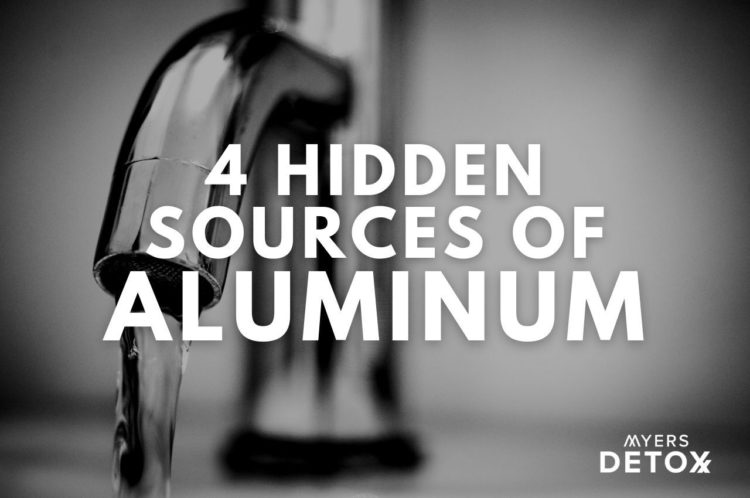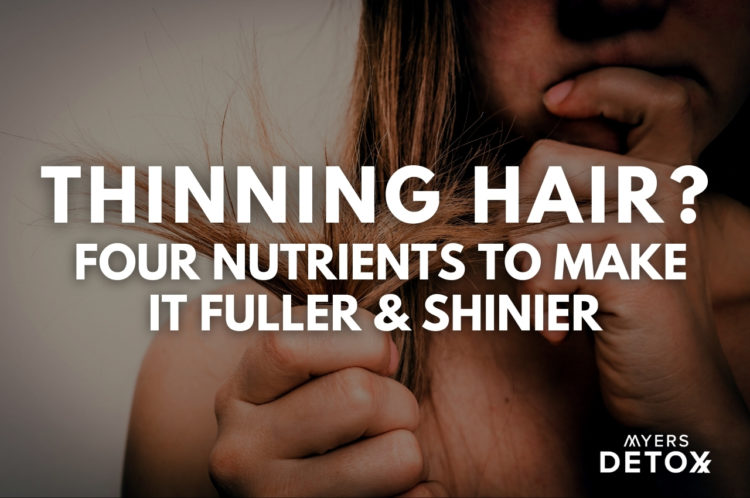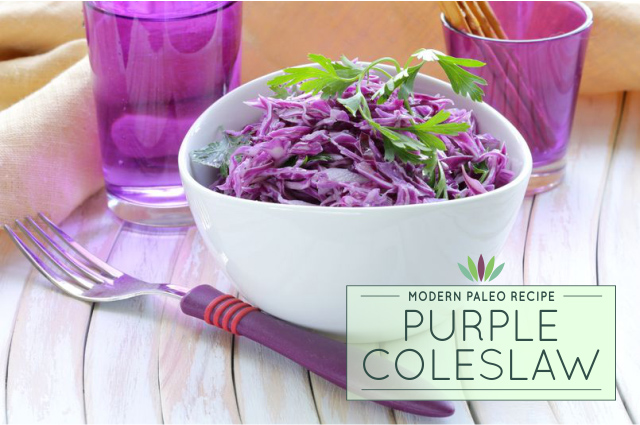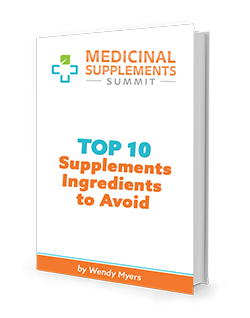4 Hidden Sources of Aluminum

Aluminum is a toxic metal that most of us are exposed to every day.
Most heavy metals are unintentional pollutants — for example, lead that leaches into drinking water from polluted soil.
Aluminum is a bit different. It’s intentionally used in a wide variety of household items, from cookware to deodorant to tap water to salt, sugar and flour as an anticaking agent.
You likely use aluminum-based products every day. The problem is that aluminum is highly toxic, and it builds up in your system over time. It hides away in your bones, fat and brain tissue, which makes it hard for your body to detox it[1]. And why it is even more important to know some of the main sources of aluminum, so that you may take steps to protect yourself.
Over the years, daily low-level aluminum exposure can contribute to devastating health problems including Alzheimer’s disease, fatigue and brain fog.
This article covers four hidden sources of aluminum and what you can do to find out how much aluminum is currently being stored inside your body.
1. Aluminum Cookware and Aluminum Foil
Aluminum cookware and aluminum foil are okay to use with some foods. As long as they don’t come into contact with acids, they remain stable.
However, cooking with acidic foods will cause pans, baking sheets, foil, and any other aluminum kitchenware to leach aluminum ions into your meal[7][8][9].
One study found that steaming rhubarb (a highly acidic vegetable) in an aluminum steaming pot caused 170 mg/kg of aluminum –170 times the safe weekly intake limit — to leach into the food[10].
Another study found that tomato puree, sauerkraut juice, and applesauce all caused significant aluminum leaching[11].
Common acidic cooking ingredients include:
- Lemon juice
- Lime juice
- Vinegar
- Tomatoes
- Most fruits
- Pickles
- Fermented foods (kimchi, sauerkraut, yogurt, sour cream, etc.)
- Beer
- Wine
If you’re going to use aluminum cookware or foil, don’t let it make contact with acidic foods.
Better yet, switch to stainless steel pots and pans — they’re almost completely nonreactive, and they’ll last you far longer than their aluminum counterparts.
Note, many restaurants use cheap disposable aluminum cookware.
2. Antiperspirant Deodorant
Deodorants are designed to neutralize the smell of your sweat. Antiperspirant deodorants are designed to stop you from sweating entirely.
Antiperspirants work by temporarily blocking the pores in your sweat glands, thereby allowing less sweat to reach the surface. The most common antiperspirants utilize aluminum salts to block your sweat production.
Using aluminum salt antiperspirants causes aluminum to build up in breast tissue[12]. Over time, aluminum buildup may interfere with estrogen levels and cause other adverse health effects in breast tissue[4][5][6].
Avoid any deodorant that says “antiperspirant” on the label. You may also want to check your deodorant’s ingredient list for aluminum chloride, aluminum chlorohydrate, or any other aluminum-based ingredient. It will likely be listed in the “active ingredients” section.
I much prefer someone use essential oil based deodorants that contain baking soda or arrowroot powder to block sweat production or absorb sweat.
3. Antacids
Antacids often contain aluminum hydroxide and magnesium hydroxide, which are used together to relieve upset stomach, acid reflux, heartburn, and indigestion.
People who took aluminum hydroxide-containing antacids showed a significant increase in both aluminum excretion and aluminum in their bloodstream[13].
The same study found that when people took an antacid with something acidic — in this case, either orange juice or citric acid, the acid in citrus fruits — their aluminum absorption was up to 50 times greater than when they took it with water.
Another study found that aluminum-based antacids interfered with calcium and phosphorus metabolism — two minerals that are essential for maintaining bone strength [14]. This isn’t surprising, considering that aluminum often displaces minerals and is stored in bone[15].
Avoid taking antacids that contain aluminum, and be doubly certain that you never take an aluminum-based antacid with acidic food (orange juice, tomatoes, fruits, fermented foods, etc.).
Better, yet, take bitter foods to stimulate acid production in the stomach or address the underlying root cause (food sensitivities, zinc deficiency, general digestive function) of the “acidic” stomach feeling so you negate the need for antacids.
4. Tap Water
Aluminum is a natural antimicrobial, meaning it kills many viruses and bacteria on contact. For that reason, many municipal water supply agencies add aluminum sulfate to drinking water.
Aluminum levels in drinking water vary based on where you live, but research shows that even small amounts of aluminum can be harmful long-term.
A 2008 study followed nearly 4000 people in 75 different areas, each of which had a unique level of aluminum in drinking water. A strong correlation showed that the more aluminum was in drinking water, the more people developed Alzheimer’s Disease[2].
Another study found that rats showed measurable aluminum build-up in their brains after a single exposure to tap water[16].
The authors concluded that “uptake of a comparable level of aluminum into the human brain, from alum-treated drinking water over a long period of time, may contribute to long-term health consequences for some people.”
Instead of tap water, choose spring water bottled in glass, or install a reverse-osmosis water filter on your faucet. It will filter out almost all pollutants, including heavy metals.
How to Detect Aluminum in Your Body
If you think you’ve been exposed to pollutants that may be damaging to your health, the best thing you can do is test your heavy metal levels.
To do this, I recommend a Hair Tissue Mineral Analysis (HTMA) test because it’s the least expensive and most convenient way to test for contaminants like aluminum. It doesn’t require any type of blood draw either – just a small sample of your hair. And there’s no need to even leave the house!
HTMA testing measures heavy metal and mineral concentrations in your hair, which is one of the most common places that heavy metals like to hide. It’s a good way to get a highly accurate snapshot of what’s going on in your body without invasive procedures or expensive scans.
Using an HTMA, you can identify exactly which heavy metals have infiltrated and been absorbed by your body so you can take actionable steps to protect your health.
The information revealed in an HTMA is crucial because, once you have pinpointed which pollutants are in your system, you can take actionable steps to:
- Support the body’s natural excretion of these pollutants from your system
- Shield yourself from further exposure to sources of these toxic health hazards
- Detox from everyday living
- Support and maintain a clean and healthy lifestyle
Once you have your HTMA test results, you can look at them with a trained practitioner and come up with a personalized plan to support your body’s natural detoxification.
If you think you’ve been exposed to health hazards like arsenic and it may be hiding in your system, order a Hair Tissue Mineral Analysis. From there, you can plan your next steps to reclaim your vitality.
*Please note that A Hair Mineral Analysis (HTMA) is not intended to diagnose, treat, cure, reverse, or prevent any disease. It is not intended to replace any other medical test(s) that may be prescribed by your medical doctor.
Click Here for References+
- Agency for Toxic Substances and Disease Registry. “Public health statement on aluminum.” Center for Disease Control (2020). https://www.atsdr.cdc.gov/phs/phs.asp?id=1076&tid=34
- Rondeau, Virginie, et al. “Relation between aluminum concentrations in drinking water and Alzheimer’s disease: an 8-year follow-up study.” American journal of epidemiology 152.1 (2000): 59-66. https://www.ncbi.nlm.nih.gov/pmc/articles/PMC2215380/
- Colomina, Maria Teresa, and Fiona Peris-Sampedro. “Aluminum and Alzheimer’s disease.” Neurotoxicity of Metals. Springer, Cham, 2017. 183-197. https://pubmed.ncbi.nlm.nih.gov/28889268/
- Linhart, Caroline, et al. “Use of underarm cosmetic products in relation to risk of breast cancer: a case-control study.” EBioMedicine 21 (2017): 79-85. https://www.ncbi.nlm.nih.gov/pmc/articles/PMC5514401/
- Darbre, Philippa D. “Aluminium, antiperspirants and breast cancer.” Journal of inorganic biochemistry 99.9 (2005): 1912-1919. https://pubmed.ncbi.nlm.nih.gov/16045991/
- Mandriota, Stefano J. “A Case-control Study Adds a New Piece to the Aluminium/Breast Cancer Puzzle.” EBioMedicine 22 (2017): 22. https://www.ncbi.nlm.nih.gov/pmc/articles/PMC5552203/
- Liukkonen‐Lilja, Helena, and Sulo Piepponen. “Leaching of aluminium from aluminium dishes and packages.” Food Additives & Contaminants 9.3 (1992): 213-223. https://pubmed.ncbi.nlm.nih.gov/1397396/
- Stahl, Thorsten, et al. “Migration of aluminum from food contact materials to food—a health risk for consumers? Part I of III: exposure to aluminum, release of aluminum, tolerable weekly intake (TWI), toxicological effects of aluminum, study design, and methods.” Environmental Sciences Europe 29.1 (2017): 19. https://www.ncbi.nlm.nih.gov/pmc/articles/PMC5388732/
- Dordevic, Dani, et al. “Aluminum contamination of food during culinary preparation: Case study with aluminum foil and consumers’ preferences.” Food science & nutrition 7.10 (2019): 3349-3360. https://www.ncbi.nlm.nih.gov/pmc/articles/PMC6804775/
- Liukkonen‐Lilja, Helena, and Sulo Piepponen. “Leaching of aluminium from aluminium dishes and packages.” Food Additives & Contaminants 9.3 (1992): 213-223. https://pubmed.ncbi.nlm.nih.gov/1397396/
- Sander, Stefan, et al. “Release of aluminium and thallium ions from uncoated food contact materials made of aluminium alloys into food and food simulant.” PLoS One 13.7 (2018): e0200778. https://www.ncbi.nlm.nih.gov/pmc/articles/PMC6056035/
- Linhart, Caroline, et al. “Use of underarm cosmetic products in relation to risk of breast cancer: a case-control study.” EBioMedicine 21 (2017): 79-85. https://www.ncbi.nlm.nih.gov/pmc/articles/PMC5514401/
- Weberg, R., and A. Berstad. “Gastrointestinal absorption of aluminium from single doses of aluminium containing antacids in man.” European journal of clinical investigation 16.5 (1986): 428-432. https://pubmed.ncbi.nlm.nih.gov/3100311/
- Spencer, Herta, et al. “Effect of small doses of aluminum-containing antacids on calcium and phosphorus metabolism.” The American journal of clinical nutrition 36.1 (1982): 32-40. https://pubmed.ncbi.nlm.nih.gov/7091034/
- Priest, N. D. “The biological behaviour and bioavailability of aluminium in man, with special reference to studies employing aluminium-26 as a tracer: review and study update.” Journal of Environmental Monitoring 6.5 (2004): 375-403. https://pubmed.ncbi.nlm.nih.gov/15152306/
- Walton, Judie, et al. “Uptake of trace amounts of aluminum into the brain from drinking water.” Neurotoxicology 16.1 (1995): 187. https://pubmed.ncbi.nlm.nih.gov/7603640/
- Eliaz, Isaac, et al. “The effect of modified citrus pectin on urinary excretion of toxic elements.” Phytotherapy Research: An International Journal Devoted to Pharmacological and Toxicological Evaluation of Natural Product Derivatives 20.10 (2006): 859-864. https://pubmed.ncbi.nlm.nih.gov/16835878/
- Sears, Margaret E. “Chelation: harnessing and enhancing heavy metal detoxification—a review.” The Scientific World Journal 2013 (2013). https://www.hindawi.com/journals/tswj/2013/219840/









